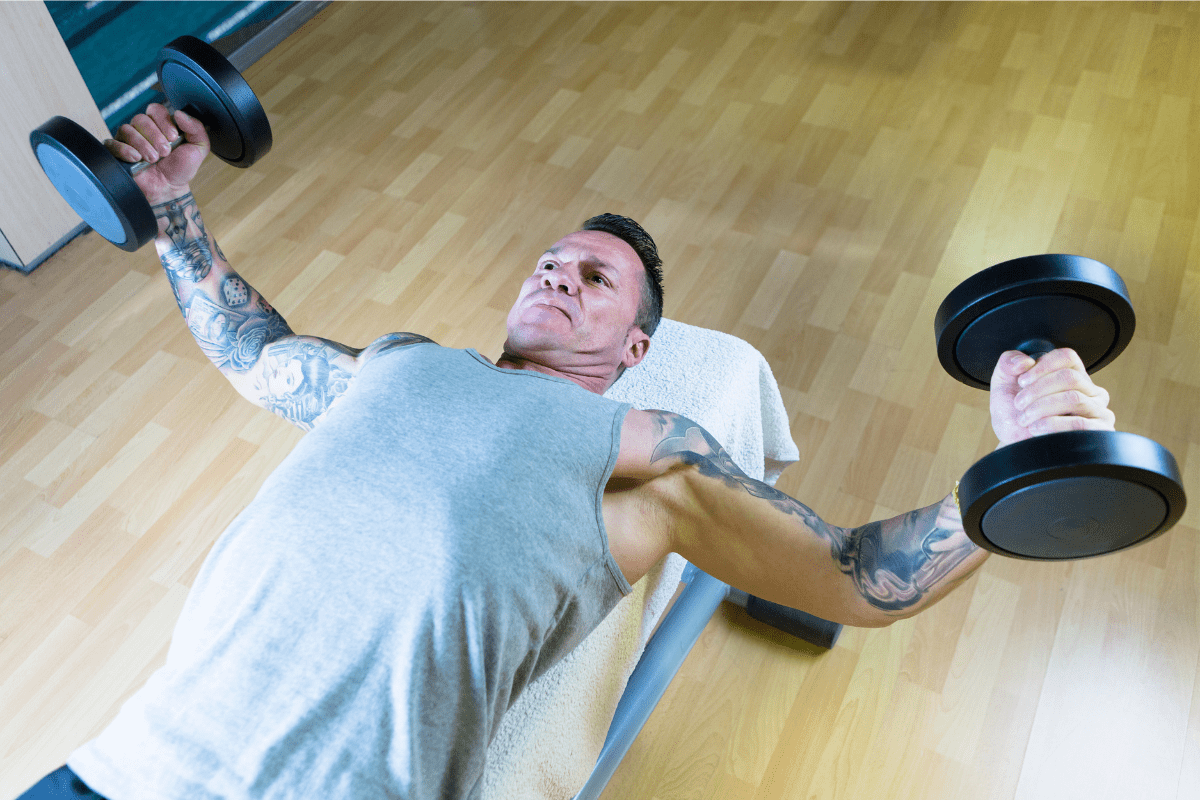Dumbbell Flys (How To, Muscles Worked, Benefits)
Dumbbell Flys are a very popular chest exercise. Walk into almost any gym and you’ll probably find someone in the dumbbell area knocking out a few sets of flys.
In this guide, I will be going over how to do Dumbbell Flys, coaching points, common mistakes, and alternatives if you happen to need them.
How To Do Dumbbell Flys
Equipment Needed
- Dumbbells
- Bench
Muscles Worked
- Chest (Pectoralis Major)
Step-by-Step Instruction
- Grab your dumbbells, sit on the edge of the bench, and sit the dumbbells on your thighs vertically.
- Take a deep breath, lie flat on your back on the bench, and get your dumbbells in position ready to press.
- Keep your feet flat on the floor and your butt on the bench.
- Pull your shoulder blades together and keep the back of your head on the bench. You will slightly arch your back. Keep your core tight and keep the shoulder blades pulled back tight.
- Press the dumbbells up.
- Now, keep a slight bend in the elbow and lower the dumbbells down until they’re at shoulder height.
- Finally, flex the chest and pull the dumbbells together, back to arm’s length over the chest.
- When your set is done, do not freely drop the dumbbells without checking your surroundings. You could drop the dumbbell and it might hit a person nearby. Or your could drop your dumbbell and crush your fingers on a dumbbell that was left next to your bench.
Coaching Points
Flys should not be done with heavy weights. Stay relatively light, keep the movement very controlled and focus on the stretch.
Remember to finish your sets with awareness so that you and your training partner/fellow gym members stay safe and injury-free. The best way to finish a set is to bring the dumbbells back to your thighs and stand up with them. Or have a lifting partner take them from you.
Benefits of Dumbbell Flys
Some potential benefits of performing Dumbbell Flys as part of a well-rounded strength training program include:
- Improved chest muscle strength and size: Dumbbell Flys can help to increase the strength and size of the chest. This can be especially beneficial for those who are looking to improve their appearance or who want to increase their upper body strength for sports or other physical activities.
- Improved shoulder stability: The shoulder muscles, including the rotator cuff and the deltoids, are also engaged during Dumbbell Flys. This can help to improve shoulder stability and reduce the risk of shoulder injuries.
- Increased range of motion: Dumbbell Flys can help to increase the range of motion in the shoulder joint, which can improve flexibility and mobility.
It’s important to note that Dumbbell Flys should be performed as part of a well-rounded strength training program that includes a variety of exercises for all major muscle groups. It’s also important to use proper form and technique to avoid injury and get the most out of this exercise.
How Many Reps?
Dumbbell Fly is a supplemental upper-body exercise. Rep ranges are typically 3 to 4 sets of 10 to 15 reps each.
Dumbbell Fly Alternatives
Don’t have dumbbells? Want to add some variety to your workout? Whatever the reason, if you need an alternative for Flys, here are a few exercises you may be able to try out.
Incline Dumbbell Flys
If you’re just looking to add a little variety to your workout, try your flys on an incline. Simply adjusting your bench up to about 45 degrees and doing Incline Dumbbell Flys can really change the feel of the exercise.
Med Ball Chest Pass
Stand in an athletic position with a lighter medicine ball (for most, 10-15 pounds will work well here). Extend the hips and aggressively chest pass the ball into the wall or to a partner. This should be fast and explosive.
Medicine Ball Chest Passes are also a great warm-up exercise for athletes getting ready for a bench day.
More Info and Links
Looking for some more great supplemental work for your bench day? Head over to our exercise library to find step-by-step exercises to help you reach your athletic potential.

